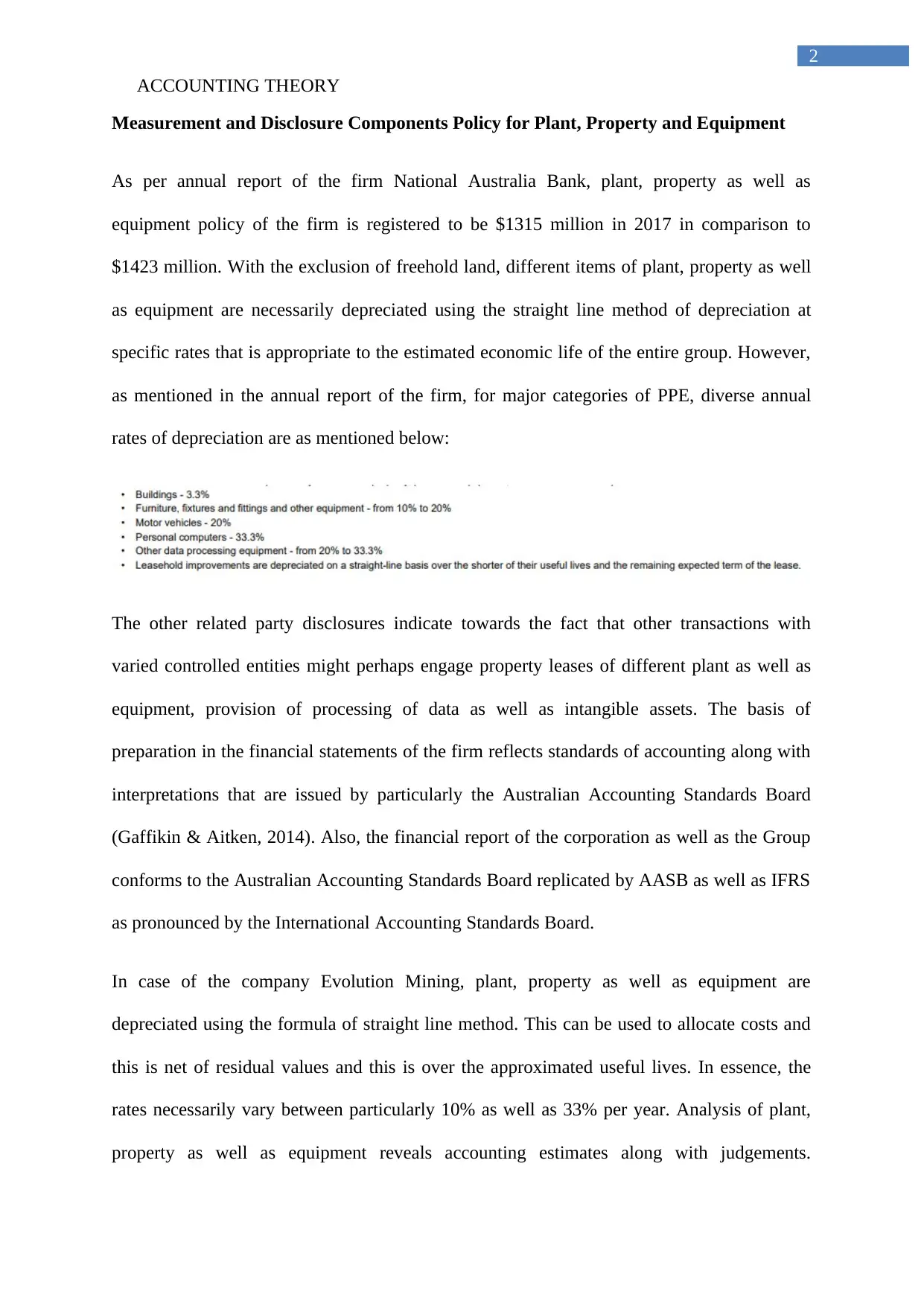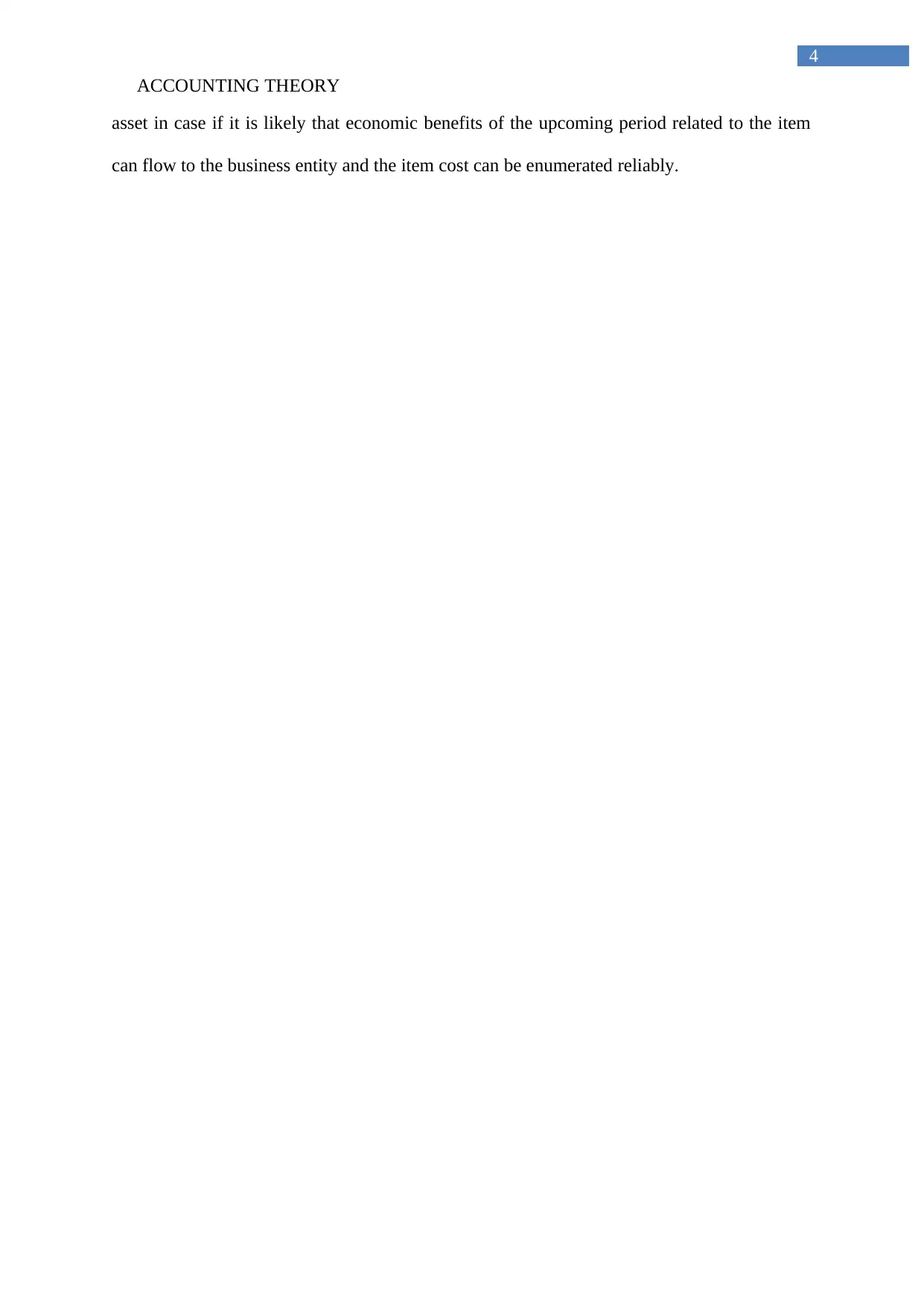Accounting Theory Report: Analysis of Accounting Policies for PPE
VerifiedAdded on 2021/05/31
|5
|883
|99
Report
AI Summary
This report analyzes accounting theory concerning Plant, Property, and Equipment (PPE), drawing on the annual reports of National Australia Bank and Evolution Mining. It explores the accounting policies related to depreciation, including the straight-line method and varying depreciation rates. The report highlights the application of AASB 116 and IFRS standards, emphasizing the importance of accounting estimates and judgments in determining economic lives and residual values. It compares the accounting treatments of PPE, focusing on recognition, depreciation methods, and disclosures, providing a comprehensive overview of accounting practices for PPE within the context of financial reporting for for-profit entities. References to Gaffikin & Aitken (2014), Scott (2015), Sin et al. (2015), and Smith et al. (2015) are included to support the analysis.

Running head: ACCOUNTING THEORY
Accounting Theory
University Name
Student Name
Authors’ Note
Accounting Theory
University Name
Student Name
Authors’ Note
Paraphrase This Document
Need a fresh take? Get an instant paraphrase of this document with our AI Paraphraser

2
ACCOUNTING THEORY
Measurement and Disclosure Components Policy for Plant, Property and Equipment
As per annual report of the firm National Australia Bank, plant, property as well as
equipment policy of the firm is registered to be $1315 million in 2017 in comparison to
$1423 million. With the exclusion of freehold land, different items of plant, property as well
as equipment are necessarily depreciated using the straight line method of depreciation at
specific rates that is appropriate to the estimated economic life of the entire group. However,
as mentioned in the annual report of the firm, for major categories of PPE, diverse annual
rates of depreciation are as mentioned below:
The other related party disclosures indicate towards the fact that other transactions with
varied controlled entities might perhaps engage property leases of different plant as well as
equipment, provision of processing of data as well as intangible assets. The basis of
preparation in the financial statements of the firm reflects standards of accounting along with
interpretations that are issued by particularly the Australian Accounting Standards Board
(Gaffikin & Aitken, 2014). Also, the financial report of the corporation as well as the Group
conforms to the Australian Accounting Standards Board replicated by AASB as well as IFRS
as pronounced by the International Accounting Standards Board.
In case of the company Evolution Mining, plant, property as well as equipment are
depreciated using the formula of straight line method. This can be used to allocate costs and
this is net of residual values and this is over the approximated useful lives. In essence, the
rates necessarily vary between particularly 10% as well as 33% per year. Analysis of plant,
property as well as equipment reveals accounting estimates along with judgements.
ACCOUNTING THEORY
Measurement and Disclosure Components Policy for Plant, Property and Equipment
As per annual report of the firm National Australia Bank, plant, property as well as
equipment policy of the firm is registered to be $1315 million in 2017 in comparison to
$1423 million. With the exclusion of freehold land, different items of plant, property as well
as equipment are necessarily depreciated using the straight line method of depreciation at
specific rates that is appropriate to the estimated economic life of the entire group. However,
as mentioned in the annual report of the firm, for major categories of PPE, diverse annual
rates of depreciation are as mentioned below:
The other related party disclosures indicate towards the fact that other transactions with
varied controlled entities might perhaps engage property leases of different plant as well as
equipment, provision of processing of data as well as intangible assets. The basis of
preparation in the financial statements of the firm reflects standards of accounting along with
interpretations that are issued by particularly the Australian Accounting Standards Board
(Gaffikin & Aitken, 2014). Also, the financial report of the corporation as well as the Group
conforms to the Australian Accounting Standards Board replicated by AASB as well as IFRS
as pronounced by the International Accounting Standards Board.
In case of the company Evolution Mining, plant, property as well as equipment are
depreciated using the formula of straight line method. This can be used to allocate costs and
this is net of residual values and this is over the approximated useful lives. In essence, the
rates necessarily vary between particularly 10% as well as 33% per year. Analysis of plant,
property as well as equipment reveals accounting estimates along with judgements.

3
ACCOUNTING THEORY
Approximation of remaining economic lives, specific residual value along with depreciation
mechanisms might perhaps include considerable judgements and are analysed yearly for
different major items of particularly plant, property as well as equipment. In essence, any
kind of alterations can be accounted for prospectively from assessment date to the end of
revised economic life (Gaffikin & Aitken, 2014). The financial statement of the firm is
necessarily a general purpose financial report that is prepared for particularly for-profit
business entity. This is as per requirements and necessities of the Corporation Act of the year
2001, other authoritative announcements of the Australian Accounting Standards Board.
Comparison of accounting theories and accounting policies
The accounting policy that can be associated to plant, property as well as equipment include
AASB 116 for plant, property as well as equipment (PPE). This accounting policy is taken
into consideration by both the firms. This policy essentially prescribes specific accounting
treatments for mainly PPE so that different users of financial assertion can discern requisite
information regarding investment of entities in PPE along with changes in this kind of
investment (Smith et al., 2015). One of the main issues involved in accounting include PPE is
related to the manner recognized asset is to be depreciated, concerning cost or fair value. In
essence, the remaining economic life and any kind of residual value at the end of the useful
life and method of depreciation by which consumption of economic benefits are essentially
consumed (Sin et al., 2015).
Disclosures for both the companies reveal that the tangible items of the firm are held for
utilization in production/supply of particularly goods as well as services, for the purpose of
renting or for administration purpose. It is also anticipated to the utilized during over and
above one accounting period (Scott, 2015). As per theory of accounting of plant, property as
well as equipment, the costs of specific items of PPE is necessarily recognized as a specific
ACCOUNTING THEORY
Approximation of remaining economic lives, specific residual value along with depreciation
mechanisms might perhaps include considerable judgements and are analysed yearly for
different major items of particularly plant, property as well as equipment. In essence, any
kind of alterations can be accounted for prospectively from assessment date to the end of
revised economic life (Gaffikin & Aitken, 2014). The financial statement of the firm is
necessarily a general purpose financial report that is prepared for particularly for-profit
business entity. This is as per requirements and necessities of the Corporation Act of the year
2001, other authoritative announcements of the Australian Accounting Standards Board.
Comparison of accounting theories and accounting policies
The accounting policy that can be associated to plant, property as well as equipment include
AASB 116 for plant, property as well as equipment (PPE). This accounting policy is taken
into consideration by both the firms. This policy essentially prescribes specific accounting
treatments for mainly PPE so that different users of financial assertion can discern requisite
information regarding investment of entities in PPE along with changes in this kind of
investment (Smith et al., 2015). One of the main issues involved in accounting include PPE is
related to the manner recognized asset is to be depreciated, concerning cost or fair value. In
essence, the remaining economic life and any kind of residual value at the end of the useful
life and method of depreciation by which consumption of economic benefits are essentially
consumed (Sin et al., 2015).
Disclosures for both the companies reveal that the tangible items of the firm are held for
utilization in production/supply of particularly goods as well as services, for the purpose of
renting or for administration purpose. It is also anticipated to the utilized during over and
above one accounting period (Scott, 2015). As per theory of accounting of plant, property as
well as equipment, the costs of specific items of PPE is necessarily recognized as a specific
⊘ This is a preview!⊘
Do you want full access?
Subscribe today to unlock all pages.

Trusted by 1+ million students worldwide

4
ACCOUNTING THEORY
asset in case if it is likely that economic benefits of the upcoming period related to the item
can flow to the business entity and the item cost can be enumerated reliably.
ACCOUNTING THEORY
asset in case if it is likely that economic benefits of the upcoming period related to the item
can flow to the business entity and the item cost can be enumerated reliably.
Paraphrase This Document
Need a fresh take? Get an instant paraphrase of this document with our AI Paraphraser

5
ACCOUNTING THEORY
References
Gaffikin, M., & Aitken, M. (Eds.). (2014). The Development of Accounting Theory (RLE
Accounting): Significant Contributors to Accounting Thought in the 20th Century.
Routledge.
Scott, W. R. (2015). Financial accounting theory (Vol. 2, No. 0, p. 0). Prentice Hall.
Sin, S., Jones, A., & Wang, Z. (2015). Critical thinking in professional accounting practice:
Conceptions of employers and practitioners. In The Palgrave Handbook of Critical
Thinking in Higher Education (pp. 431-456). Palgrave Macmillan, New York.
Smith, B.J., Thomas, M. & Batras, D., (2015). Overcoming disparities in organized physical
activity: findings from Australian community strategies. Health promotion
international, 31(3), pp.572-581.
ACCOUNTING THEORY
References
Gaffikin, M., & Aitken, M. (Eds.). (2014). The Development of Accounting Theory (RLE
Accounting): Significant Contributors to Accounting Thought in the 20th Century.
Routledge.
Scott, W. R. (2015). Financial accounting theory (Vol. 2, No. 0, p. 0). Prentice Hall.
Sin, S., Jones, A., & Wang, Z. (2015). Critical thinking in professional accounting practice:
Conceptions of employers and practitioners. In The Palgrave Handbook of Critical
Thinking in Higher Education (pp. 431-456). Palgrave Macmillan, New York.
Smith, B.J., Thomas, M. & Batras, D., (2015). Overcoming disparities in organized physical
activity: findings from Australian community strategies. Health promotion
international, 31(3), pp.572-581.
1 out of 5
Related Documents
Your All-in-One AI-Powered Toolkit for Academic Success.
+13062052269
info@desklib.com
Available 24*7 on WhatsApp / Email
![[object Object]](/_next/static/media/star-bottom.7253800d.svg)
Unlock your academic potential
Copyright © 2020–2025 A2Z Services. All Rights Reserved. Developed and managed by ZUCOL.





